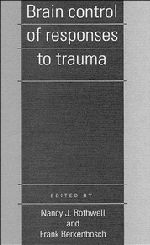Book contents
- Frontmatter
- Contents
- Contributors
- 1 Introduction
- 2 Responses to injury
- 3 Experimental approaches to the central nervous system control of responses to trauma
- 4 Neurohormonal control of cytokines during injury
- 5 Brain regions involved in modulation of immune responses
- 6 Psychological and neurobiological consequences of trauma
- 7 Central nervous system control of sickness behavior
- 8 Psychological and behavioural aspects of pain
- 9 Central control of cardiovascular responses to injury
- 10 Neuroendocrine responses to physical trauma
- 11 Central control of metabolic and thermoregulatory responses to injury
- 12 Central control of pain
- 13 The final word …
- Index
6 - Psychological and neurobiological consequences of trauma
Published online by Cambridge University Press: 05 August 2016
- Frontmatter
- Contents
- Contributors
- 1 Introduction
- 2 Responses to injury
- 3 Experimental approaches to the central nervous system control of responses to trauma
- 4 Neurohormonal control of cytokines during injury
- 5 Brain regions involved in modulation of immune responses
- 6 Psychological and neurobiological consequences of trauma
- 7 Central nervous system control of sickness behavior
- 8 Psychological and behavioural aspects of pain
- 9 Central control of cardiovascular responses to injury
- 10 Neuroendocrine responses to physical trauma
- 11 Central control of metabolic and thermoregulatory responses to injury
- 12 Central control of pain
- 13 The final word …
- Index
Summary
Introduction
Human reactions to trauma have been characterized for more than a century by various labels, including compensation neurosis (Rigler, 1879), hysteria (Putnam, 1881), nervous shock (Page, 1885), traumatophobia (Rado, 1942), and war neurosis (Grinker & Spiegel, 1943). More recently, a large cluster of these reactions has been subsumed under posttraumatic stress disorder (PTSD) (American Psychiatric Association, 1980), described as an anxiety disorder precipitated by an event ‘outside the range of usual human experience’ (p. 250) and characterized by symptoms of reexperiencing (e.g. nightmares, flashbacks), avoidance and numbing (e.g. avoidance of reminders, psychogenic amnesia), and arousal (e.g. difficulty sleeping, exaggerated startle) that persist longer than 1 month posttrauma. The fourth edition of the Diagnostic and Statistical Manual of Mental Disorders (DSM-IV) is expected to retain the symptoms described above, but modify the trauma criterion to include the individual's perception of threat rather than the rarity of the event. The duration criterion is likely to include the subtypes of ‘acute’ and ‘chronic’ to describe the course of the reaction.
PTSD was introduced into the third edition of the DSM (DSM-III) (American Psychiatric Association, 1980) primarily in response to the large number of Vietnam combat veterans who manifested the above symptoms, but the disorder has been evidenced following other traumas as well, including rape (Kilpatrick et al, 1987; Rothbaum et al, 1992), accidents (Muse, 1986; Burstein et al, 1988), natural disasters such as volcanoes, fires, tornadoes, floods, and mudslides (Lindy et al, 1983; Shore et al, 1986; Smith et al, 1986; Bravo et al, 1990; Green et al, 1990, 1991), and disasters such as the nuclear accident at Three Mile Island, fire, and collapse of dams and skywalks (Baum et al, 1983; Wilkinson, 1983; Bromet et al, 1984; Green et al, 1990, 1991). The duration of these reactions is quite variable: some individuals experience traumatic events with apparently no long-lasting adverse effects, whereas other victims seem to suffer permanent damage, with one study finding continuing negative effects after 14 years posttrauma (Green et al, 1990). The percentage of people who develop PTSD following various traumas, and the course of their reactions, are addressed below.
- Type
- Chapter
- Information
- Brain Control of Responses to Trauma , pp. 123 - 151Publisher: Cambridge University PressPrint publication year: 1994



